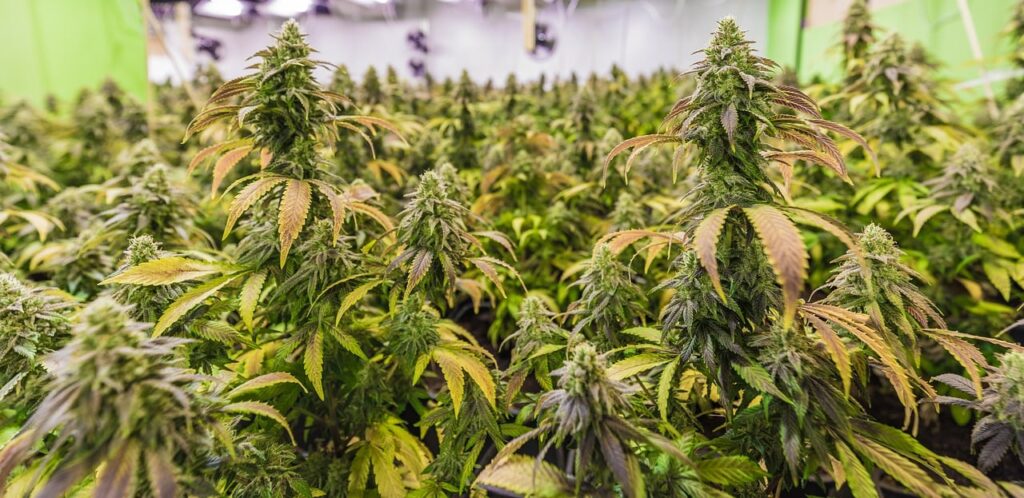Last summer, New Mexico state special agents made a startling discovery while inspecting a farm: they found thousands more cannabis plants than state laws allow. During subsequent visits, they uncovered an even more disturbing sight: dozens of underfed and traumatized Chinese workers.
These workers revealed they had been trafficked to the Torrance County farm in New Mexico, barred from leaving, and had not received any payment for their labor.
“They appeared weathered and deeply frightened,” recalls Lynn Sanchez, director of a New Mexico social services nonprofit who was called in following the raid.
These workers are part of a new influx of migrants from China, entering the U.S. through unauthorized border crossings from Mexico. Many of them end up working on cannabis farms that are proliferating across the U.S. An NPR investigation into several cannabis “grow” operations in New Mexico revealed businesses primarily managed and funded by Chinese individuals. These businesses are tapping into the booming U.S. cannabis market, which has expanded significantly following the economic fallout from the COVID-19 pandemic. However, some operations have clashed with legal standards, despite states like New Mexico legalizing marijuana.
Escaping Hardship in China
One worker from the farm in Torrance County, known only as “L.,” is a 41-year-old from Hubei province, China. He chose to remain anonymous due to fears of legal repercussions in both the U.S. and China. L. shared his struggles with NPR, describing how he couldn’t find work during the pandemic lockdown and was displaced when a state developer demolished his home for a new project that was never built. After a physical altercation with the developer’s employees, L. was jailed, leaving him disillusioned.
It was then that L. discovered videos on Douyin, China’s equivalent of TikTok, showing people allegedly earning good money in the U.S. “There was this one influencer who kept sending me his pay stubs from California, claiming he was making $4,000 to $5,000 a month and how easy it was,” L. recalls. This led him to contact an agent who promised to help him get to the U.S.
Inspired by Douyin videos, L. learned how to “walk the line” to the U.S.-Mexico border. His arduous journey took him from Turkey to Ecuador and through the treacherous Darién Gap jungle in South America. He faced multiple robberies and life-threatening conditions before finally crossing into the U.S. in May 2023.
The New Migrant Route
L.’s experience is part of a larger trend of Chinese migrants taking the same land route traditionally used by Caribbean and South American migrants. In the past year, U.S. border authorities encountered 37,000 Chinese nationals crossing irregularly into the southern border — a number exceeding the total from the past decade combined. After being apprehended and released by U.S. border officials in July, pending his asylum claim, L. rented a room in Monterey Park, California, a hub for the Chinese immigrant community.
There, fellow Chinese immigrants directed him to labor agencies that placed undocumented workers for a fee. An advertisement for “cutting grass” in a greenhouse, promising $4,000 a month in cash, caught L.’s attention.
Enslaved on the Farm
L. and a group of other recent Chinese migrants were transported to a New Mexico grow operation called Bliss Farm. Shocked by the sight of approximately 200 greenhouses, they were forced to stay after their phones and passports were confiscated by the managers.
“The farm promised to cover food and shelter, allowing us to save our wages,” explained a Bliss Farm worker from Shenyang, who also requested anonymity due to his pending asylum application. “But the farm was just a vast dirt field.”
The workers endured 15-hour shifts, and at night, they slept in makeshift wooden sheds with dirt floors. Despite their grueling labor, none were paid before the operation was shut down.
New Mexico authorities, alerted to the poor worker conditions and zoning violations, visited the farm last year. “It was a disaster site with trash, leaking water, fertilizers, nutrients, and pesticides,” recounts Todd Stevens, director of the state’s Cannabis Control Division. “Red flags were everywhere as soon as we arrived.”
The farm was raided in August 2023. Sanchez, from The Life Link, described the laborers’ dire condition: “They had visible burns on their hands and arms, reportedly from chemicals. They looked severely malnourished.”
L. and two other workers found at the farm have applied for asylum, with their cases pending. Bliss Farm’s license was revoked, and the operation was fined $1 million for exceeding state grow limits.
The Marijuana Gold Rush
With marijuana becoming a lucrative industry in the U.S., where nearly half the states have legalized it for recreational use and about two-thirds for medical use, New Mexico legalized recreational marijuana in 2021. This led to a rush to purchase residential land for cannabis cultivation.
“People were eager to capitalize on the marijuana boom,” says Don Goen, a planning and zoning director in Torrance County. “Some had a solid plan, while for others, it was more of a dream.”
Investigations by ProPublica have uncovered connections between some U.S. cannabis operations and Chinese diplomats, Communist Party-affiliated organizations, and local Chinese criminal syndicates. However, NPR found no evidence of Chinese state or organized crime involvement in the operations discussed in this report. Instead, these businesses attracted small-scale investors from China seeking to profit from the expanding market.
Investors and Misfortune
Ella Hao, an accountant from Shandong province, China, moved to Los Angeles with her husband in 2020 to secure passports for their U.S.-born children. In September 2020, encouraged by Chinese-speaking immigrants, Hao and her husband invested $30,000 in a New Mexico marijuana farm near Shiprock, a venture started by Dineh Benally, a former Navajo Nation farm board president facing legal issues over hemp cultivation on Native land.
In 2022, Hao and her husband invested another $300,000 to buy land in Oklahoma, aiming to set up a cannabis grow operation. Despite obtaining a grow license, the venture never materialized.
Oklahoma’s lax enforcement and cheap land prices created a “perfect storm” for such investments, says Donnie Anderson, director of the Oklahoma Bureau of Narcotics.
Legal Troubles and Exploitation
Close to Bliss Farm, another marijuana grow operation in Shiprock, N.M., was under scrutiny. This venture, also started by Benally, faced a lawsuit from 15 Chinese workers who accused him and his associates of forcing them to work 14-hour shifts without pay, physical abuse, and preventing them from leaving the site. Benally, who later attempted to start a new operation in Torrance County, is now facing multiple legal challenges.
Benally’s operation had involved several Chinese investors. One partner, Irving Rea Lin, was arrested in California during a crackdown on illegal grows. Another backer, Xiaofeng Peng, a solar panel entrepreneur wanted in China for fraud, is a fugitive. NPR’s attempts to contact him were unsuccessful. A third associate, Bryan Peng, started a similar grow in Oklahoma using workers from the Shiprock farm, which was also raided and closed.
In a tragic incident in November 2022, investor Chen Wu killed four workers on an Oklahoma farm over a financial dispute. Wu is now serving a life sentence.
Hao, who lost her investments, is now raising her two children in California and supporting them through short-term jobs, including pruning marijuana plants at a licensed grow operation.
“We didn’t understand the documents because we don’t speak English, and now we have nowhere to turn,” Hao laments.
Conclusion
These stories shed light on the dark side of the burgeoning U.S. cannabis industry, where vulnerable migrants are exploited and the promise of quick wealth often leads to legal and financial ruin.
“Inside the Chinese-funded and Staffed Marijuana Farms Springing up across the U.S.” Www.Npr.Org, 24 Jun. 2024, www.npr.org/2024/06/24/1238497863/chinese-marijuana-farms-new-mexico. Accessed 24 Jun. 2024.

